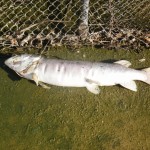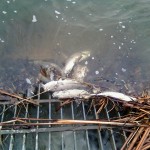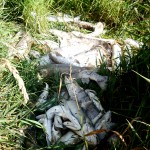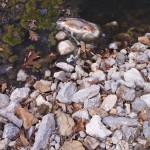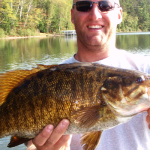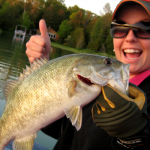By Kenny Lookingbill
As I was doing my normal inventory checks in February and ordering supplies for the upcoming open water season, I reflected back on the winter, and the lack of ice fishing opportunities. It was also a very snowy winter, with more than 80″ of snow, making it the third snowiest winter on record. The combination of all of these factors made ice fishing conditions very miserable. The thought of winter fish kills began to cross my mind. I remained optimistic though, hoping for a best case scenario with there only being partial fish kills.
As the area warmed up at a very agonizing slow pace, I started to hear reports of fish kills in central Illinois, particularly Lake Eureka. At that point I began to fear the worst. As most of my favorite subdivision ponds began to open up I went out to investigate. The scenes at some of these holes were catastrophic. One pond in particular was hit very hard. As I approached the pond, the one shoreline was lined with seagulls, and I had a bad feeling about what I was about to stumble upon. The seagulls scattered as I approached, and my worst fears were confirmed. Fish of every species and size class were dead, washed up on the bank and strewn across the grass even as much as ten yards from the bank. There were even dead bullfrogs, something I had not seen previously.

This winter, Eureka Lake in Central Illinois was devastated by a massive die-off. Image courtesy Dana Lee.
What causes winter fish kills?
A multitude of factors play into the occurrence and severity of fish kills. The number one factor is ice and cover. As ice builds on bodies of water and subsequent snowfalls cover the ice, a couple of things occur. First, there is no air-water contact, meaning no diffusion of oxygen into the water. More importantly, there is no light penetration for the aquatic vegetation resulting in no photosynthesis occurring. With no photosynthesis, the vegetation isn’t producing oxygen as a byproduct and the vegetation starts to die off. The decomposition process can consume oxygen rapidly and drop dissolved oxygen levels to critical concentrations.
Other factors that play a role in winter fish kills are fish biomass, water volume, and how productive the water is. The more fish that are present in a body of water in relation to the amount of water present, the higher the chance of a fish kill occurring. This is due to a higher oxygen demand because there are more fish, and there is more competition for those oxygen resources. Volume of water present is important simply because the more water there is, the more oxygen load the lake has initially before ice cover.
Bigger, deeper lakes have more water, and are more likely to survive a harsh winter with little or no casualties. Small, shallow bodies of water like ponds have limited oxygen resources to begin with, and therefore cannot withstand longer winters. Water productivity is important because ponds and lakes that tend to be more productive, having more production at the lower trophic levels like vegetation and zooplankton, tend to experience fish kills. While productive bodies of water tend to produce bigger fish because of the increased production of resources at the lower levels, this is detrimental to ponds during the winter months because increased productivity of water requires more oxygen. These same highly eutrophic bodies of water can experience summer kills as well.
What can be done to prevent winter fish kills?
There are no real good ways to prevent a fish kill during the winter months. Some anglers swear by shoveling snow off the ice and drilling holes for light penetration, but this will have very limited effects. The best thing to do as a pond owner is to turn on the aerator if it has one. Dredging out the pond to make it deeper can also help, but that is very costly. Otherwise winter kills are a just a natural occurrence and there is not much that can be done.
The best thing to do when you come across a fish kill of any kind is to alert local DNR officials and tell them how many fish and what sizes so that they can gauge the severity of the kill and what future measures need to be taken. Most of the time there will be limited re-stocking and there are enough fish left in the pond or lake that the fish population will bounce back naturally within a couple of years. In the case of a more severe kill or even in rare cases a complete kill, the pond will need more intensive management and may need a complete re-stocking. More severe kills will have fish of all species and size classes dead.
Once again, DNR officals can advise you in those situations and re-stock the body of water if it needs it. There are also private organizations that stock fish as well.
Documented Reports 2014
So far this year, there have been scattered reports of fish kills across upper Midwest, ranging from Lake Eureka in Central Illinois to the clusters of natural lakes of Chippewa County in Northern Wisconsin. Additionally, unofficial reports from guides and anglers are also coming out of Wisconsin’s Vilas and Oneida counties, especially from shallower, boggy eutrophic lakes that are prone to high weedgrowth and nutrient levels. Locally for me, many ponds in Northern Illinois have also experienced fish kills due to their size and ice cover, some of them catastrophic. The DNR’s of Michigan, Wisconsin, and Minnesota are already expecting a large spike in winter fish kills. And the situation isn’t getting any better as there is still thick ice cover on most of the lakes along with fresh snow cover.
Science students at a high school in Chippewa County in Northwest Wisconsin were working on a year long project on Horseshoe Lake when they discovered a fish kill after putting an underwater camera to monitor beneath the ice. A couple of small metro lakes in the Minneapolis area also suffered a heavy winterkill which includes Snail Lake in Shoreview and North Center Lake in Lindstrom. North Center Lake is particularly alarming because the lake has no previous history of winter kills and reaches depths of 40 feet.
Other Minnesota lakes reporting kills are the following: Pelican Lake and the north end of Maple Lake in Wright County; Little Sunrish, Spider, and north Goose Lakes in Chisago County; Centerville Lake in Anoka County; Long Lake, North and South Stanchfield, Francis and Paul’s Lakes in Isanti County.
Unfortunately, reports of fish kills throughout the Upper Midwest will continue to pour in as further ice melts, and there will likely be a few local popular fisheries devastated. It may take them years to rebound through natural reproduction and restocking efforts. As painful as it is for us to hear, winter fish kills are a natural occurrence and happen every so often. Sometimes, they may even improve certain fisheries by weeding overpopulated stunted fish and allow for faster growth rates and larger gamefish. That is the best that many anglers can hope for on some of their favorite bodies of water in the upcoming seasons.




